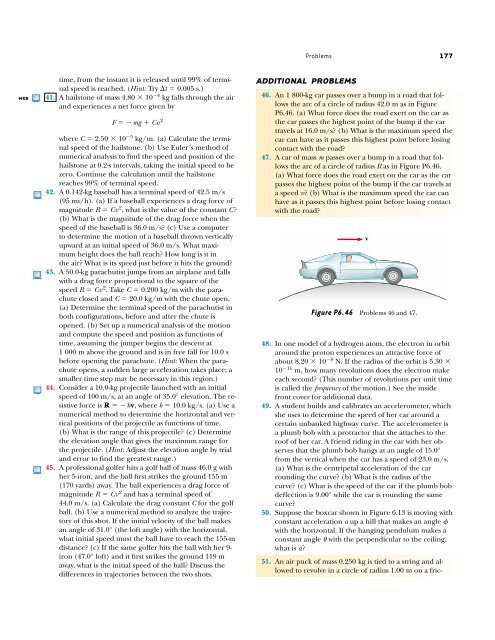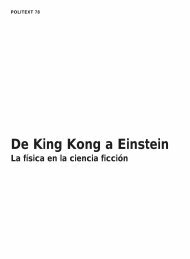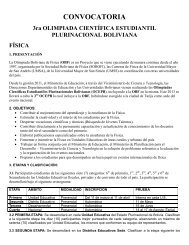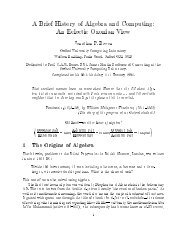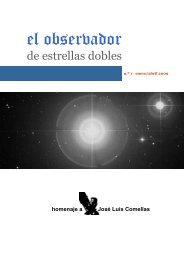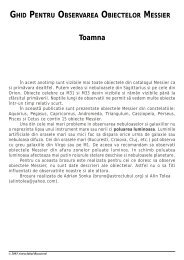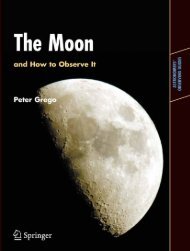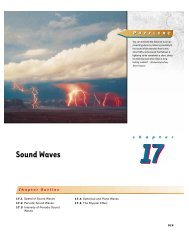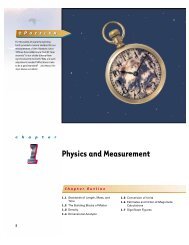Circular Motion and Other Applications of Newton's Laws
Circular Motion and Other Applications of Newton's Laws
Circular Motion and Other Applications of Newton's Laws
Create successful ePaper yourself
Turn your PDF publications into a flip-book with our unique Google optimized e-Paper software.
WEB<br />
time, from the instant it is released until 99% <strong>of</strong> terminal<br />
speed is reached. (Hint: Try �t � 0.005 s.)<br />
41. A hailstone <strong>of</strong> mass 4.80 � 10 �4 kg falls through the air<br />
<strong>and</strong> experiences a net force given by<br />
F ��mg � Cv 2<br />
where C � 2.50 � 10�5 kg/m. (a) Calculate the terminal<br />
speed <strong>of</strong> the hailstone. (b) Use Euler’s method <strong>of</strong><br />
numerical analysis to find the speed <strong>and</strong> position <strong>of</strong> the<br />
hailstone at 0.2-s intervals, taking the initial speed to be<br />
zero. Continue the calculation until the hailstone<br />
reaches 99% <strong>of</strong> terminal speed.<br />
42. A 0.142-kg baseball has a terminal speed <strong>of</strong> 42.5 m/s<br />
(95 mi/h). (a) If a baseball experiences a drag force <strong>of</strong><br />
magnitude R � Cv 2 , what is the value <strong>of</strong> the constant C?<br />
(b) What is the magnitude <strong>of</strong> the drag force when the<br />
speed <strong>of</strong> the baseball is 36.0 m/s? (c) Use a computer<br />
to determine the motion <strong>of</strong> a baseball thrown vertically<br />
upward at an initial speed <strong>of</strong> 36.0 m/s. What maximum<br />
height does the ball reach? How long is it in<br />
the air? What is its speed just before it hits the ground?<br />
43. A 50.0-kg parachutist jumps from an airplane <strong>and</strong> falls<br />
with a drag force proportional to the square <strong>of</strong> the<br />
speed R � Cv 2 . Take C � 0.200 kg/m with the parachute<br />
closed <strong>and</strong> C � 20.0 kg/m with the chute open.<br />
(a) Determine the terminal speed <strong>of</strong> the parachutist in<br />
both configurations, before <strong>and</strong> after the chute is<br />
opened. (b) Set up a numerical analysis <strong>of</strong> the motion<br />
<strong>and</strong> compute the speed <strong>and</strong> position as functions <strong>of</strong><br />
time, assuming the jumper begins the descent at<br />
1 000 m above the ground <strong>and</strong> is in free fall for 10.0 s<br />
before opening the parachute. (Hint: When the parachute<br />
opens, a sudden large acceleration takes place; a<br />
smaller time step may be necessary in this region.)<br />
44. Consider a 10.0-kg projectile launched with an initial<br />
speed <strong>of</strong> 100 m/s, at an angle <strong>of</strong> 35.0° elevation. The resistive<br />
force is R ��bv, where b � 10.0 kg/s. (a) Use a<br />
numerical method to determine the horizontal <strong>and</strong> vertical<br />
positions <strong>of</strong> the projectile as functions <strong>of</strong> time.<br />
(b) What is the range <strong>of</strong> this projectile? (c) Determine<br />
the elevation angle that gives the maximum range for<br />
the projectile. (Hint: Adjust the elevation angle by trial<br />
<strong>and</strong> error to find the greatest range.)<br />
45. A pr<strong>of</strong>essional golfer hits a golf ball <strong>of</strong> mass 46.0 g with<br />
her 5-iron, <strong>and</strong> the ball first strikes the ground 155 m<br />
(170 yards) away. The ball experiences a drag force <strong>of</strong><br />
magnitude R � Cv <strong>and</strong> has a terminal speed <strong>of</strong><br />
44.0 m/s. (a) Calculate the drag constant C for the golf<br />
ball. (b) Use a numerical method to analyze the trajectory<br />
<strong>of</strong> this shot. If the initial velocity <strong>of</strong> the ball makes<br />
an angle <strong>of</strong> 31.0° (the l<strong>of</strong>t angle) with the horizontal,<br />
what initial speed must the ball have to reach the 155-m<br />
distance? (c) If the same golfer hits the ball with her 9iron<br />
(47.0° l<strong>of</strong>t) <strong>and</strong> it first strikes the ground 119 m<br />
away, what is the initial speed <strong>of</strong> the ball? Discuss the<br />
differences in trajectories between the two shots.<br />
2<br />
Problems 177<br />
ADDITIONAL PROBLEMS<br />
46. An 1 800-kg car passes over a bump in a road that follows<br />
the arc <strong>of</strong> a circle <strong>of</strong> radius 42.0 m as in Figure<br />
P6.46. (a) What force does the road exert on the car as<br />
the car passes the highest point <strong>of</strong> the bump if the car<br />
travels at 16.0 m/s? (b) What is the maximum speed the<br />
car can have as it passes this highest point before losing<br />
contact with the road?<br />
47. A car <strong>of</strong> mass m passes over a bump in a road that follows<br />
the arc <strong>of</strong> a circle <strong>of</strong> radius R as in Figure P6.46.<br />
(a) What force does the road exert on the car as the car<br />
passes the highest point <strong>of</strong> the bump if the car travels at<br />
a speed v? (b) What is the maximum speed the car can<br />
have as it passes this highest point before losing contact<br />
with the road?<br />
Figure P6.46 Problems 46 <strong>and</strong> 47.<br />
48. In one model <strong>of</strong> a hydrogen atom, the electron in orbit<br />
around the proton experiences an attractive force <strong>of</strong><br />
about 8.20 � 10�8 N. If the radius <strong>of</strong> the orbit is 5.30 �<br />
10�11 m, how many revolutions does the electron make<br />
each second? (This number <strong>of</strong> revolutions per unit time<br />
is called the frequency <strong>of</strong> the motion.) See the inside<br />
front cover for additional data.<br />
49. A student builds <strong>and</strong> calibrates an accelerometer, which<br />
she uses to determine the speed <strong>of</strong> her car around a<br />
certain unbanked highway curve. The accelerometer is<br />
a plumb bob with a protractor that she attaches to the<br />
ro<strong>of</strong> <strong>of</strong> her car. A friend riding in the car with her observes<br />
that the plumb bob hangs at an angle <strong>of</strong> 15.0°<br />
from the vertical when the car has a speed <strong>of</strong> 23.0 m/s.<br />
(a) What is the centripetal acceleration <strong>of</strong> the car<br />
rounding the curve? (b) What is the radius <strong>of</strong> the<br />
curve? (c) What is the speed <strong>of</strong> the car if the plumb bob<br />
deflection is 9.00° while the car is rounding the same<br />
curve?<br />
50. Suppose the boxcar shown in Figure 6.13 is moving with<br />
constant acceleration a up a hill that makes an angle �<br />
with the horizontal. If the hanging pendulum makes a<br />
constant angle � with the perpendicular to the ceiling,<br />
what is a?<br />
51. An air puck <strong>of</strong> mass 0.250 kg is tied to a string <strong>and</strong> allowed<br />
to revolve in a circle <strong>of</strong> radius 1.00 m on a fric-<br />
v


